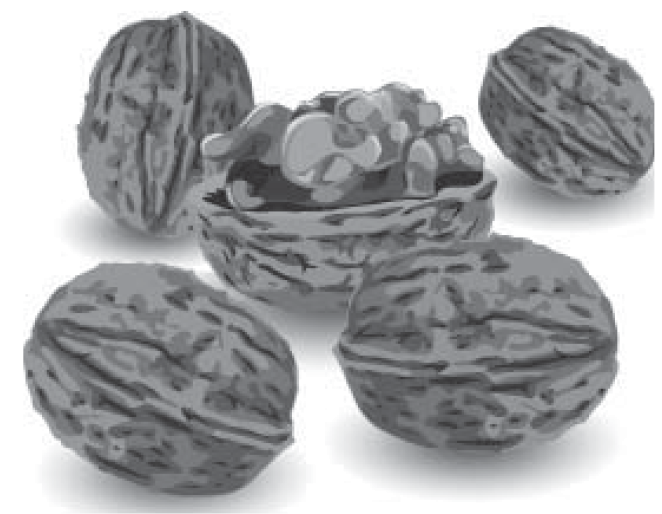Background Agricultural Connections
California walnut farmers have scientifically learned how to produce nuts with thinner skins, larger nutmeat, and disease and pest resistant trees through a process called grafting. Grafting is a common type of plant propagation where healthy and disease resistant rootstock is fused onto a scion. A scion is a shoot from another plant that contains the desired genes to be duplicated in future production. The scion is often selected due to its leaves, flowers, and in the case of the walnut, its fruit.
Black walnuts are indigenous to California, however their thick shell and small nut size are not ideal for human consumption. However, the English walnut that is native to Ancient Persia, now known as Iran, produces walnuts with thinner shells and larger nuts making them a better choice for consumers. English walnuts are more prone to diseases and pests because they are not native to California. This is why California walnut farmers graft black walnut rootstock onto English walnut scions.
There are a number of types of grafting. The most common type is called whip or tongue grafting. Grafting is done in the late spring after the rootstock has produced leaves and is less likely to fail. The most difficult step in grafting is making sure that sap doesn’t flow from the cut rootstock. To avoid this “bleeding,” farmers need to be mindful of weather conditions. In periods of heavy rain or strong temperature fluctuations, bleeding is more likely to occur.
 Black walnut seeds are planted during October through December. The seedlings emerge in early spring. The seedlings continue growing for one full year until they are strong and large enough to be grafted. Scions, from English walnut trees, are selected for their well-developed buds are collected during the dormant winter months from December to February. They are placed in moist wood shavings or a plastic bag in a refrigerator until the rootstock is ready.
Black walnut seeds are planted during October through December. The seedlings emerge in early spring. The seedlings continue growing for one full year until they are strong and large enough to be grafted. Scions, from English walnut trees, are selected for their well-developed buds are collected during the dormant winter months from December to February. They are placed in moist wood shavings or a plastic bag in a refrigerator until the rootstock is ready.
When grafting, it is important to choose a piece of scion wood that closely matches the diameter of the rootstock. The scion and rootstock are both diagonally cut during the whip grafting process. A small slit is cut into the center of the cut pieces. The two cut pieces are matched together and the small slits help lock the rootstock and scion together. The union is sealed with grafting or masking tape. A rubber compound called yellow cap is also used. The young rootstock is painted white to protect it from the sunlight. The top of the unexposed scion is sealed with a grafting wax to keep the top of the walnut tree from drying out.
 Black walnut seeds are planted during October through December. The seedlings emerge in early spring. The seedlings continue growing for one full year until they are strong and large enough to be grafted. Scions, from English walnut trees, are selected for their well-developed buds are collected during the dormant winter months from December to February. They are placed in moist wood shavings or a plastic bag in a refrigerator until the rootstock is ready.
Black walnut seeds are planted during October through December. The seedlings emerge in early spring. The seedlings continue growing for one full year until they are strong and large enough to be grafted. Scions, from English walnut trees, are selected for their well-developed buds are collected during the dormant winter months from December to February. They are placed in moist wood shavings or a plastic bag in a refrigerator until the rootstock is ready.